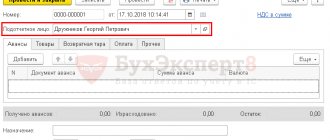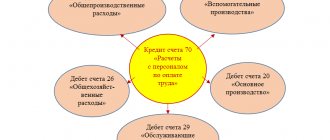Government structures responsible for developing regulations for the provision of subsidies are listed in Art. 78.1 BC RF. Institutions may receive subsidized resources to carry out certain government tasks or achieve specific goals. In the first case, the organization undertakes to report at the end of the financial period on the use of funds allocated to it and the degree of readiness of the task. If there are legally approved conditions, unclaimed funds must be returned to the budget.
Question: If an institution has not completed the task in terms of achieving indicators for the volume or quality of services (work), it should have unspent subsidy funds, which should be returned to the budget. What funds should the institution use to do this if the subsidy amount is completely spent? View answer
Failure to fulfill government orders.
In accordance with paragraph 6 of Art. 69.2 of the Budget Code of the Russian Federation, a state (municipal) task is unfulfilled in the event of failure to achieve (exceeding the permissible (possible) deviation) indicators characterizing the volume and quality of state (municipal) services provided (work performed).
Paragraph 46 of Regulation No. 640[1] provides for the following procedure for the return of subsidies in the event of failure to fulfill a state task:
- If, based on the report on the implementation of the state task, the volume indicators indicated in the report are less than the indicators established in the state task (taking into account permissible (possible) deviations), then the subsidy funds are subject to transfer to the budget in the amount corresponding to the unachieved indicators and are taken into account in the manner determined to account for the amount of receivables returned.
- Calculation of the volume of the subsidy to be returned to the budget is carried out using standard costs for the provision of public services (performance of work) in the form provided for in the agreement on the provision of the subsidy. An approximate format for this calculation is given in Appendix 2 to the Standard form of an agreement on the provision of a subsidy to a federal budgetary or autonomous institution for financial support for the implementation of a state task for the provision of public services (performance of work), approved by Order of the Ministry of Finance of the Russian Federation dated October 31, 2016 No. 198n.
- Federal budgetary or autonomous institutions ensure the return of subsidies to the federal budget in the amount of unachieved indicators no later than May 1 of the current financial year.
When calculating the amount of subsidy to be returned, the following must be taken into account:
- formulas for calculating the volume of subsidy balances formed due to failure to achieve state target indicators and subject to return to the budget are given in Letter of the Ministry of Finance of the Russian Federation dated 02/05/2016 No. 02‑01‑09/5870;
- the volume of the subsidy for the state task, subject to return to the budget, is determined on the basis of the values of the standard costs for the provision of public services (performance of work) and the unfulfilled volume of the state task for each state service (work). In addition, when calculating, one should take into account possible deviations in indicators within which the state task is considered completed (Letter of the Ministry of Finance of the Russian Federation dated April 11, 2016 No. 02-01-09/20628);
- if the actual volume of individual services provided (work performed) is higher than that provided for in the state assignment, then the excess amount is not taken into account when calculating the amount of the remaining subsidy to be returned to the budget (Letter of the Ministry of Finance of the Russian Federation dated April 12, 2016 No. 02‑01‑09/20629) .
In accounting, the return of subsidy balances is reflected in the following accounting entries (clauses 150, 158, 133 of Instruction No. 174[2], clauses 178, 180, 161 of Instruction No. 183n[3]):
| Contents of operation | Debit | Credit |
| Budgetary (autonomous) institutions have accrued debt to return to budget revenue the balances of subsidies for the state task, formed in connection with the failure to achieve the indicators established by the state task characterizing the volume of state (municipal) services (works), based on the report on the implementation of the state task | 4 401 40 131 | 4 303 05 731 |
| The debt to return the remaining subsidy has been repaid | 4 303 05 831 | 4 201 11 610 |
8
According to the state task approved for the State Budgetary Institution “Physical Culture and Recreation Complex”, the number of people involved should be 1,100 people (an indicator characterizing the volume of state work “Organization and conduct of sports and recreational work for the development of physical culture and sports among various groups of the population”) with taking into account a possible deviation of 10%. The approved amount of standard costs for performing such work is 337,700 rubles. (RUB 307 – cost per unit of work per person involved). The actual volume of work, according to the report on the implementation of the state task, amounted to 900 people.
For other public services (works) included in the state assignment, indicators characterizing the volume and quality of services (works) have been fully achieved. The return of funds to the budget is carried out at the expense of the total balance of the subsidy for the state task that arose at the end of the year and amounts to 50,000 rubles.
We will calculate the amount of the subsidy to be returned due to failure to achieve the indicators established in the state task.
To begin with, we will determine the possible deviation of the indicator for the work performed, within which the state task is considered completed. It is 110 people. (1,100 people x 10%). Taking into account possible deviations, the outstanding volume of government work is 90 people. (1 100 - 110 - 900).
Based on the standard costs for one person involved, the sports institution must return 27,630 rubles to the budget. (90 people x 307 rub./person).
| Contents of operation | Debit | Credit | Amount, rub. |
| Debt was accrued for the return of subsidies for government tasks due to failure to achieve established indicators | 4 401 40 131 | 4 303 05 731 | 27 630 |
| The debt was repaid using the total balance of the subsidy for the government task | 4 303 05 831 | 4 201 11 610 Off-balance sheet account 18 (Article 610 KOSGU*) | 27 630 |
* The article is applied in accordance with clause 14.1 of Order No. 209n[4].
The difference between the total unused balance of the subsidy for the state task and the balance formed in connection with the failure to achieve the state task indicators in the amount of 22,370 rubles. (50,000 - 27,630) the institution has the right to use in the next year in accordance with the financial and economic activity plan.
How to account for the return of an advance from a buyer in a budget institution?
QUESTION We paid the supplier 100% under the contract (RUB 50,000.00). The supplier stopped fulfilling the terms of the contract (goods were delivered for RUB 30,000.00), we initiated termination of the contract with him (the supplier must return RUB 20,000.00 to us) At 206.34 We have 20,000.00 rubles. 12/31/18 posting 209.34/206.34 was made. Is the wiring done correctly?
Or should I use account 401.40? ANSWER The wiring is done correctly.
If the supplier has been paid an advance and he has not fulfilled his obligations within the time period specified in the contract, then the debt from account 206.34 must be transferred to account 209.34.
It is necessary to reflect these transactions as soon as you begin to conduct claims work with the counterparty.
In this case, there is no need to wait until the end of the financial year (clause 109 of Instruction 174n*). RATIONALE From paragraph 7 of the “Revenue” standard, it follows that amounts should be attributed to deferred income when it is not considered possible to determine the exact monetary amount of income. In addition, according to the rules of the GHS “Income”, for accounting and reporting purposes, income is considered to be the receipt of economic benefits.
In your case, we are talking about compensation for costs incurred by the institution. Therefore, it is enough to reflect the debt of the counterparty in the amount of unfulfilled obligations by posting: Debit 0 209 34 560 Credit 0 206 34 660 If the case is sent to court, then when awaiting the amounts of forced seizure it will be possible to use account 401.40 “Deferred income”.
Based on the clarifications of the Ministry of Finance of Russia, given in Letter N 02-05-11/62851, and the provisions of paragraph 301 of Instruction N 157n, the expected income from claims raised, disputed by the supplier, is recognized as deferred income and is subject to reflection in account 1 401 40 141 “Revenue future periods from penalties for violation of procurement legislation and violation of the terms of contracts (agreements)”, since the amount of such income cannot be reliably estimated.
Early termination of government assignments.
According to clause 41 of Regulation No. 640, in the event of early termination of the execution of a state task, the unused balances of the subsidy in the amount corresponding to the indicators characterizing the volume of unprovided public services (uncompleted work) are subject to transfer in the prescribed manner by budgetary or autonomous institutions to the budget and are taken into account in the manner prescribed for accounting for receivables returns.
The grounds for early termination of the execution of a state task are reflected in the state task itself (Clause 1, Article 69.2 of the Budget Code of the Russian Federation). These include:
- liquidation of the institution;
- adoption, in accordance with the established procedure, of a decision on the reorganization of an institution, as a result of which the institution ceases to operate as a legal entity;
- redistribution of powers, resulting in the exclusion from the competence of the institution of the authority to provide public services (carry out public work);
- changes in current regulatory legal acts, as a result of which the further implementation of the state task will contradict these acts;
- the occurrence (detection) during the implementation of a state task of circumstances that do not allow it to be completed for reasons beyond the control of the institution;
- poor quality performance of a government task or violation of the terms of such task;
- other cases provided for by the legislation of the Russian Federation.
In our opinion, in accounting, operations to return unused subsidy funds to the budget are reflected in the same way as the return of a subsidy in case of failure to fulfill a government task.
3
In the event of early termination of the execution of a state task in connection with the reorganization of a budgetary or autonomous institution, the unused balances of the subsidy are subject to transfer to the relevant budgetary and autonomous institutions that are legal successors (clause 41 of Regulation No. 640).
Form 737
Attention! To bring accounting records generated by documents from January 1, 2021 until the installation of release 1.0.32 to the new rules for using off-balance sheet accounts 17 and 18, external processing “ Updating payment documents 2021 ” (PDActual_21003 file) is used. The PDActual_21003 file is contained in the configuration update templates directory.
Form 737. Filling out.
Column 8 - reflects non-cash transactions for expenses provided for by planned assignments for the current (reporting) financial year, as in the case of income, performed without taking into account the movement of funds .
In the financial statements for the reporting year, only significant events after the reporting date are subject to reflection, that is, events without knowledge of which a reliable assessment of the financial condition, cash flow or results of the organization’s activities is impossible. The significance of an event after the reporting date is determined by the organization independently based on the general requirements for financial statements (clause 6 of PBU 7/98).
The need for balances has not been confirmed.
By virtue of clause 9 of Procedure No. 59[5], the balances of the targeted subsidy provided to budgetary (autonomous) institutions of the Ministry of Sports that are not used in the current financial year are subject to transfer to the federal budget in accordance with Procedure No. 82n[6]. At the same time, such balances can be spent by the institution in the next financial year for the same purposes when the Ministry of Sports makes a decision on the need for the remainder of the targeted subsidy, agreed with the Ministry of Finance.
According to Procedure No. 82n, unused balances of targeted subsidies, in respect of which the bodies exercising the functions and powers of the founder have not decided on the need to direct them for the same purposes in the current financial year, are subject to collection.
In order to confirm the need for the balances of the targeted subsidy, the budgetary (autonomous) institution, no later than May 20 of the current financial year, submits to the territorial body of the Federal Treasury (OFC), in which it has opened a separate personal account for accounting for transactions with targeted subsidies, information approved by the founder on transactions with targeted subsidies for 20__ (f. 0501016) indicating the balance of targeted funds allowed for use.
If the institution does not provide the above information before the specified date, the territorial OFK, no later than the tenth working day after June 1 of the current financial year, collects the balance of targeted subsidies by transferring them to an account opened on balance sheet account 40101 “Income distributed by Federal Treasury bodies between budgets of the budget system of the Russian Federation”, for subsequent transfer of balances to the federal budget revenue.
Taking into account the above procedure for collecting the balances of targeted subsidies to an institution that has not confirmed the need for them, it is advisable to transfer such balances to the budget and not wait for the funds to be written off forcibly.
Let's look at the procedure for reflecting the return of a targeted subsidy using an example.
9
The Olympic Reserve School (budgetary institution), on the basis of an agreement concluded with the founder, has been provided with a targeted subsidy from the budget this year for the payment of scholarships in the amount of 500,000 rubles. Based on the report, the amount of confirmed expenses due to the targeted subsidy amounted to 483,000 rubles. Unused balance of the subsidy in the amount of RUB 17,000. the institution returned:
- at the end of the current year;
- early next year.
In accounting, these transactions are reflected as follows:
| Contents of operation | Debit | Credit | Amount, rub. |
| Income accrued in the form of a targeted subsidy based on the concluded agreement | 5 205 52 561 | 5 401 40 152 | 500 000 |
| A targeted subsidy has been received to a separate personal account | 5 201 11 510 | 5 205 52 661 | 500 000 |
| Off-balance sheet account 17 (subarticle 152 of KOSGU) | |||
| Accrued expenses for payment of scholarships | 5 401 20 296 | 5 302 96 737 | 483 000 |
| Scholarships have been transferred to bank cards of college students | 5 302 96 837 | 5 201 11 610 | 483 000 |
| Off-balance sheet account 18 (subarticle 296 of KOSGU) | |||
| The income of the current financial year for the provided subsidy has been accrued in accordance with the report on the expenditure of targeted funds | 5 401 40 152 | 5 401 10 152 | 483 000 |
| Return of the subsidy to the budget at the end of the current year | |||
| Debt has been accrued to return the balance of unspent subsidy funds to budget revenues | 5 401 40 152 | 5 205 52 661 | 17 000 |
| Unused balances of the targeted subsidy were returned | 5 205 52 561 | 5 201 11 610 Off-balance sheet account 17 (subarticle 152 of KOSGU) | 17 000 |
| Return of the subsidy to the budget early next year | |||
| Debt has been accrued to return the balance of unspent subsidy funds to budget revenues | 5 401 40 152 | 5 303 05 731 | 17 000 |
| Unused balances of the targeted subsidy were returned | 5 303 05 831 | 5 201 11 610 Off-balance sheet account 18 (Article 610 KOSGU) | 17 000 |
When the need for the remaining subsidy is confirmed, the transferred funds are transferred to the institution’s account or the debt to the budget is written off (if the funds were not transferred to the budget). In accounting, these transactions will be reflected in the following entries:
| Contents of operation | Debit | Credit |
| Subsidy funds were returned to the budget until a decision was made to confirm the need for their use | ||
| Unused subsidy funds were credited to the institution’s personal account | 5 201 11 510 Off-balance sheet account 17 (Article 510 KOSGU) | 5 205 52 661 5 205 62 661 |
| Subsidy funds were not transferred to the budget until a decision was made to confirm the need for their use | ||
| The debt to return the remainder of the subsidy to the budget has been written off | 5 303 05 831 | 5 205 52 661 5 205 62 661 |
What will change in KOSGU from 2021
From 2021, a new procedure for applying KOSGU will be in effect. The Ministry of Finance prepared a table in which it compared KOSGU-2018 and KOSGU-2021.
Comparative table of the procedure for applying the classification of operations of the general government sector, established by Order of the Ministry of Finance dated July 1, 2013 No. 65n (2018), and the procedure for applying the classification of operations of the general government sector established by Order of the Ministry of Finance dated November 29, 2017 No. 209n (2021) KOSGU 2021 (65n)KOSGU 2021 (209n) Group 100 Income 9.
Group 100 “Income” is detailed by KOSGU articles: This group is detailed by KOSGU articles 110 - 180, within which operations related to income are grouped. 110 “Tax revenues and customs payments”; 120 “Income from property”; 130 “Income from the provision of paid services (work), compensation of costs”; 140 “Fines, penalties, penalties, compensation for damage”; 150 "Free
Violations in the use of subsidies have been identified.
Violations are identified based on the results of subsequent state (municipal) financial control. The main violation, as a rule, is the misuse of subsidies.
Targeted subsidies must be used in strict accordance with the purposes of their provision outlined in the relevant agreements. Control over the use of targeted subsidies can be exercised by the founders, as well as by state (municipal) financial control bodies, which include:
- The Accounts Chamber of the Russian Federation, control and accounting bodies of the constituent entities of the Russian Federation and municipalities - bodies of external state (municipal) financial control;
- The Federal Treasury, bodies of state (municipal) financial control, which are respectively bodies (officials) of the executive power of constituent entities of the Russian Federation, local administrations, are bodies of internal state (municipal) financial control.
In addition, for the misuse of subsidy funds (that is, the direction of funds received from the budget of the budgetary system of the Russian Federation for purposes that do not correspond to the goals defined by the agreement), a budgetary (autonomous) institution may be brought to administrative liability under Art. 15.14 Code of Administrative Offenses of the Russian Federation (Letter of the Federal Treasury dated August 10, 2017 No. 07‑04‑05/09-665).
In the accounting of a budgetary (autonomous) institution, operations to return targeted subsidy funds to the budget in the event of violations being detected based on the results of control activities will be reflected in the following accounting entries (clauses 152, 93 of Instruction No. 174n, clauses 180, 96 of Instruction No. 183n):
| Contents of operation | Debit | Credit |
| The institution's debt has been accrued to return to budget revenue the balances of unused subsidies for other purposes in the event that, based on the results of subsequent state (municipal) financial control, violations of the procedure for using these subsidies are identified | 5 401 10 152 (162) 5 401 10 152 (162) | 5 303 05 731 |
| The debt to return the remaining subsidy has been repaid | 5 303 05 831 | 5 201 11 610 |
Miassats.Ru
Yours will be the first! budget process - the activities of state authorities, local governments and other participants in the budget process regulated by the legislation of the Russian Federation in the preparation and consideration of draft budgets, approval and execution of budgets, control over their execution, implementation of budget accounting, preparation, external verification, consideration and approval of budget reporting; ACCOUNTING FOR ACCEPTED LIABILITIES AND (OR) MONETARY OBLIGATIONS is carried out on the basis of documents confirming their acceptance in accordance with the list established by the institution as part of the formation of accounting policies, taking into account the requirements for authorizing the payment of accepted monetary obligations established by the financial authority; skatb.ru New in accounting and reporting of budgetary institutions Order of the Ministry of Finance of the Russian Federation dated November 16, 2016 No. 209n introduced changes to 6 instructions on accounting and reporting for budgetary institutions.
Repayment of debt and short-term contracts in accounting
Accounts receivable is one of the shares of an enterprise's working capital. These amounts represent the number of liabilities owed to the company.
Repayment of accounts receivable is the payment of amounts of obligations that an organization owes from individuals and legal entities as a result of economic interactions.
You should understand the difference between writing off and paying off accounts receivable. Write-off of accounts receivable is an assignment to the financial result, or to another indicator, of debt that cannot be repaid.
The accounts receivable posting will look like this:
Dt 51 (52) Kt 62 - repayment of DZ by buyers for purchased products.
You can manage accounts receivable by stimulating customers to pay off debt early
Accounts payable are an obligation of an enterprise to other organizations - creditors. Most often, the debt is a debt to suppliers, employees of the organization (wages), the budget, extra-budgetary funds, loans, etc.
This debt is repaid if:
- fulfillment of a debt obligation;
- written off as unclaimed.
Short circuit write-off can be performed in the following cases:
- if the statute of limitations has passed;
- it is impossible to fulfill the obligation (reorganization of the enterprise or inability to collect the debt).
Repayment of accounts payable entails its reduction. There are the following ways to repay a loan:
- mutually beneficial change in the debt structure;
- attraction of a mutual settlement mechanism;
- Compensation is one of the last measures; in this case, property is accepted as repayment.
Repayment of accounts payable occurs at the time of full settlement with creditors
In the posting of the KZ accounting accounts, cash accounts are debited and credited accordingly:
- Dt 60, 62, 70, 68, etc.;
- Kt 50, 51, 52 and others.
Reinstatement of a written-off creditor's debt
Even when the statute of limitations for the creditor has expired, this does not mean that the company will no longer be able to fulfill the agreement with the client. The Civil Code of the Russian Federation allows you to fulfill obligations even after the expiration of the statute of limitations.
Accountants recognize the write-off to the income of a creditor with an expired statute of limitations as erroneous if there is agreement to close the obligation. But at a time when the statute of limitations has expired, according to the norms of the Tax Code, it is required to recognize KZ as non-operating income.
Tax officials may consider the restoration of the KZ incorrect, since this restoration is similar to a free transfer. However, this can be disputed. Since the restoration of accounts payable after write-off can be used in the form of other justified expenses, for example, non-operating expenses.
To avoid disputes with tax authorities, it is better to take into account VAT as part of accounts payable when classifying the latter as non-operating income
How to deal with VAT in this situation? From the amount that was received earlier, the company paid tax to the budget. And the cost, together with VAT, is included in income. Therefore, when restoring a short-circuit, it is better to include the same amount in expenses.
At the end of the limitation period, the short-term claim is liquidated by posting: Dt 62 Kt 91/1.
In a situation where the counterparty has agreed to resume cooperation, it is important to document this.
Upon approval of the agreement, the enterprise acknowledges its debt to the counterparty, and he receives the right to claim the debt at any time. Therefore, adoption will cause a decrease in economic benefits.
The restoration of written-off accounts payable is reflected by the following transactions:
| Debit | Credit | Operation description |
| Dt 91/2 | Kt 62 | Reflection of expenses |
| Dt 76 | Kt 91/1 | VAT recovery |
| Dt 68 | Kt 99 | Reflection of a tax asset |
Thus, the restoration of accounts payable will not entail negative results for the seller. However, the absence of official letters may lead to doubts during the inspection.
When recovering accounts payable, there are no VAT consequences
Important! The Client is not allowed to restore expired receivables unilaterally. Therefore, in the case of a bilateral agreement, the best solution would be to formalize the agreement.
Reinstatement of the debtor and creditor occurs when one of the parties recognizes a debt with an expired statute of limitations, or when errors were made in accounting. The procedure itself is not that complicated, but it is very important to document this procedure.
In order not to have to carry out this procedure, it is necessary to approach the accounting of receivables and creditors with special care, regularly work with them, in order to avoid the expiration of the statute of limitations, work with counterparties, reconcile with contractors, and also oblige departments cooperating with counterparties to carry out prevention of overdue debts.





